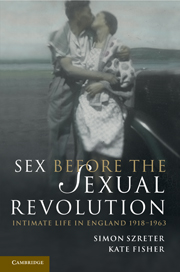Book contents
- Frontmatter
- Contents
- Acknowledgements
- 1 Introduction
- Part I What was sex?
- Part II What was love?
- Part III Exploring sex and love in marriage
- 10 Conclusion: private lives
- Appendix A The oral history sample: summary of project design and socio-demographic characteristics of the interviewees in Blackburn and north-west Hertfordshire
- Appendix B Note on social classification of the respondents
- Appendix C
- Bibliography
- Index
- Index of interviewees
Appendix B - Note on social classification of the respondents
Published online by Cambridge University Press: 05 June 2012
- Frontmatter
- Contents
- Acknowledgements
- 1 Introduction
- Part I What was sex?
- Part II What was love?
- Part III Exploring sex and love in marriage
- 10 Conclusion: private lives
- Appendix A The oral history sample: summary of project design and socio-demographic characteristics of the interviewees in Blackburn and north-west Hertfordshire
- Appendix B Note on social classification of the respondents
- Appendix C
- Bibliography
- Index
- Index of interviewees
Summary
Respondents were assigned a social class status affiliation using an adapted version of the Registrar-General's social classification of male occupations – the official scheme that was in use throughout the period 1911 to 1991.
The official scheme has changed little but the description and precise occupational contents of each of the six categories have gone through a number of modifications during its long existence. The descriptions below best fit the manner in which it has been used here:
Class I higher professional, administrative and managerial, those with inherited wealth
Class II lower professional, and middle administrative and managerial in large organisations
Class IIIN clerical workers
Class IIIM skilled manual workers
Class IV partly skilled manual workers
Class V unskilled manual workers
In this study the scheme's categories have been further modified by the creation of two additional ‘social class’ affiliations, ‘II/IIIM’ and ‘IIIM/II’. This is to deal with a well-known weakness of the R-G's scheme: its failure to recognise the distinctive social significance of the private sector, small business community. The more substantial businessmen, such as directors, financiers, managers or owners of large enterprises, can be satisfactorily classified to Class I or Class II, on the basis of their professional qualifications, educational and family background, and wealth. But there remains a large number of small businessmen and independent, petit bourgeois traders, for whom the official classification is inadequate, since it is misleading to place these either in Class IIIN or IIIM. Class IIIM, of course, contains a range of skilled manual workers, who are typically subordinate, waged employees.
- Type
- Chapter
- Information
- Sex Before the Sexual RevolutionIntimate Life in England 1918–1963, pp. 392 - 393Publisher: Cambridge University PressPrint publication year: 2010



